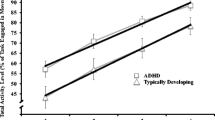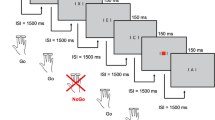Abstract
This study was designed as a replication of previous studies describing dynamic EEG differences between behaviorally dissimilar groups. This study is intended as a reference point from which other researchers can continue to establish the EEG correlates of “on-task” behavior. Eight Attention Deficit Disordered (ADD) children and eight Normally Achieving Controls (NAC) were assessed using dynamic EEG measures. Results are reported for the tasks of baseline (eyes open), reading, and drawing as recorded from FZ, CZ, PZ, C3, and C4. Significant amplitude differences between the groups were demonstrated in the theta band (4–8 hertz) during all tasks and for all sites. Amplitude differences in the beta band (12–20 hertz) were negligible. Differences between groups expressed as a ratio of theta/beta revealed significant differences mainly in the parietal region for on-task conditions. These results are discussed in relation to EEG neuro-feedback training paradigms and the importance of establishing normative “on-task” EEG values.
Similar content being viewed by others
References
American Psychiatric Association (1987).Diagnostic and statistical manual of mental disorders (3rd ed.—revised Washington, DC: Author.
Canadian Achievement Tests (1980). Canadian Test Centre, 55 Citizen Court, Markham, Ontario: Levels 12–19.
Fein, G., Galin, D., Yingling, C. D., Johnstone, J., & Nelson, M. A. (1984). EEG spectra in 9–13 year old boys are stable over 1–3 years.Electroencephalography and Clinical Neurophysiology, 58 517–518.
Gasser, T., Verleger, R., Bacher, P., & Sroka, L. (1988). Development of the EEG of school-aged children and adolescents. I. Analysis of band power.Electroencephalography and Clinical Neurophysiology, 69 91–99.
Hanley, J., & Sklar, B. (1976). Electroencephalographic correlates of developmental reading dyslexias: Computer analysis of recordings from normal and dyslexic children. In G. Leisman (ed.).Basic visual processes and learning disability (pp. 217–241). Springfield, MA: Charles C. Thomas Publisher.
Janzen, T. M. (1992).Comparing the dynamic EEG of successful and attention deficit disordered grade 5 and 6 boys. Unpublished Master's Thesis. University of Alberta.
Jasper, H. H. (1958). The 10–20 electrode system of the international federation.Electroencephalography and Clinical Neurophysiology, 10 371–375.
John, E. R., Karmel, B. Z., Corning, W. C., Easton, P., Brown, D., Ahn, H., John, M., Harmony, T., Princhep, L., Toro, A., Gerson, I., Bartlett, F., Thatcher, R., Kaye, H., Valdes, P., & Schwartz, E. (1977). Neurometrics.Science, 196 1393–1410.
Koppitz, E. M. (1975).The Bender Gestalt Test for Young Children (Vol. 2). Research and application. New York: Grune & Stratton.
Lairy, C. G. (1975). The evolution of the EEG in normal children and adolescents from 1 to 21. In A. Remond (ed.).Handbook of electroencephalography and clinical neurophysiology (Vol. 6B) EEG evolution from birth to adulthood (pp. 31–68). Amsterdam: Elsevier Scientific Publishing Company.
Lexicor Medical Technology. (1990).Neurosearch-24 User's Manual, Boulder, Colorado.
Lubar, J. F. (1985a). EEG biofeedback and learning disabilities.Theory into Practice, 24 106–111.
Lubar, J. F. (1985b). Spectral analysis of EEG differences between children with and without learning disabilities.Journal of Learning Disabilities, 18 403–408.
Lubar, J. F. (1989). Electroencephalographic biofeedback and neurological applications. In J. V. Basmajian (Ed.),Biofeedback: Principles and practice for clinicians (3 ed., pp. 67–90). Baltimore: Williams & Wilkins.
Lubar, J. F. (1991). Discourse of the development of EEG diagnostics and biofeedback for Attention-Deficit/Hyperactivity Disorders.Biofeedback and Self-Regulation, 16 201–225.
Lubar, J. F., Bianchini, B. A., Calhoun, W. H., Lambert, E. W., Brody, Z. H., & Shasbin, H. S. (1985). Spectral analysis of EEG differences between children with and without learning disabilities.Journal of Learning Disabilities, 18 403–408.
Lubar, J. F., Gross, D. M., Shively, M. S., & Mann, C. A. (1990). Differences between normal, learning disabled and gifted children based upon an auditory evoked potential task.Journal of Psychophysiology, 4 249–260.
Lubar, J. O., & Lubar, J. F. (1984). Electroencephalographic biofeedback of SMR and beta for treatment of Attention Deficit Disorders in a clinical setting.Biofeedback and Self-Regulation, 9 1–23.
Lubar, J. F., Mann, C. A., Gross, D. M., & Shively, M. S. (1992). Differences in semantic event related potentials in learning disabled, normal and gifted children.Biofeedback and Self Regulation, 17 41–57.
Lubar, J. F., & Shouse, M. N. (1976). EEG and behavioral changes in a hyperkinetic child concurrent with training of the sensorimotor rhythm (SMR).Biofeedback and Self-Regulation, 1 293–306.
Mann, C., Lubar, J. F., Zimmerman, A. W., Miller, C. A., & Muenchen, R. A. (1992). Quantitative analysis of EEG in boys with Attention Deficit-Hyperactivity Disorder (ADHD): A controlled study with clinical implications.Pediatric Neurology, 8 30–36.
Matousek, M., & Petersen, I. (1973). Frequency analysis of the EEG in normal children and adolescents. In P. Kellaway & I. Petersen (Eds.).Automation of clinical electroencephalography (pp. 75–103). New York: Raven Press Publishers.
Senf, G. M. (1988). Neurometric brain mapping in the diagnosis and rehabilitation of cognitive dysfunction.Cognitive Rehabilitation, 6 20–37.
Shouse, M. N., & Lubar, J. F. (1979). Operant conditioning of EEG rhythms and Ritalin in the treatment of hyperkinesis.Biofeedback and Self-Regulation, 4 299–311.
Tansey, M. A. (1984). EEG sensorimotor rhythm biofeedback training: Some effects on the neurological precursors of learning disabilities.International Journal of Psychophysiology, 1 163–177.
Tansey, M. A. (1985). Brainwave signatures: An index reflective of the brain's functional neuroanatomy: Further findings on the effect of EEG sensorimotor rhythm biofeedback training on the neurological precursors of learning disabilities.International Journal of Psychophysiology, 3 85–99.
Tansey, M. A., & Bruner, R. L. (1983). EMG and EEG biofeedback training in the treatment of a 10-year-old hyperactive boy with a developmental reading disorder.Biofeedback and Self-Regulation, 8 25–37.
Author information
Authors and Affiliations
Additional information
The authors wish to acknowledge contributions of Hazel Dean school administration and students. Also, thanks are offered to Allan Pankratz for his assistance with graphics.
Rights and permissions
About this article
Cite this article
Janzen, T., Graap, K., Stephanson, S. et al. Differences in baseline EEG measures for ADD and Normally Achieving preadolescent males. Biofeedback and Self-Regulation 20, 65–82 (1995). https://doi.org/10.1007/BF01712767
Issue Date:
DOI: https://doi.org/10.1007/BF01712767




